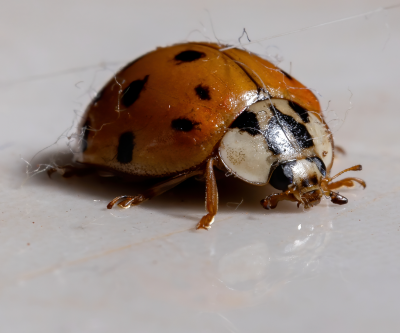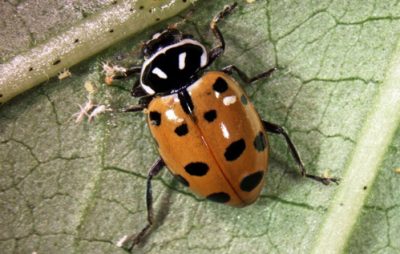Ladybugs are cute and adorable unless they swarm your house in the thousands or millions.
Handling ladybug this level of infestations can be overwhelming and leave you paralyzed due to the sheer numbers.
Don’t worry; I’m here to help. In this post, I’ll teach you everything you need to know about ladybug infestations and how to get rid of them.
Let’s dive in and get your home back.
How To Get Rid of Ladybugs Indoors?
1. Vacuuming
The easiest way to get rid of ladybugs is to vacuum them up with a HEPA filter vacuum. This will prevent any debris from entering the air and causing allergic reactions.
The benefit of vacuuming them is that you won’t harm them if you use a canister vacuum. After vacuuming them, you can release them outside.
Vacuuming is an easy way to get rid of any current ladybugs, but it won’t help you kill or get rid of ladybugs in the future.
As ladybugs continue to enter your home, you will need to go through several vacuuming cycles to make sure you remove all ladybugs.
2. Use a Light Trap
Ladybugs are attracted to light, similar to mosquitoes and other flying insects. This means that light traps are highly effective at trapping ladybugs inside your home.
You can place these near key entry points such as windows, doors, or cracks and crevices. The light will attract the ladybugs, and the vacuum will suck them in.
This is highly effective because they are weak flyers.
Other light traps use glue traps. I prefer to avoid using glue traps since the ladybugs need to land on the trap physically. Vacuum traps are more effective because if they fly near the trap, they will get sucked in.
3. Act Fast
One important thing you can do to make sure that you act fast when you anticipate a ladybug infestation. Applying repellents and chemical insecticides early will make it easier to get rid of the ladybugs.
Acting fast will also allow you to repel the ladybugs and avoid killing them in most cases.
This will also allow you to seal all entry points before they can get inside. It will prevent any chances of ladybugs laying eggs inside your home.
4. Use Chemical Insecticide
One of the easiest things you can do is to apply chemical insecticide to your home. If there are many ladybugs, you can use the chemical directly on the ladybugs.
You want to get an insecticide with a residual effect. This will ensure that any ladybugs that land on the surface after you’ve applied the insecticide will also die.
You can also apply the insecticide directly to any cracks or crevices. This will limit the number of ladybugs that can enter your home.
You should also apply the insecticide on the window and door sills. These are common areas that ladybugs enter homes. Applying insecticide here will treat them before they can enter your home.
5. Seal All Entry Points
One of the easiest ways to get rid of ladybugs inside your home is to weatherstrip your home. You need to do a few key things to make sure ladybugs can’t enter your home.
First, apply weatherstripping foam to all window and door sills. This will fill any small gaps that ladybugs could enter through.
Next, apply door sweeps to the bottom of your door to prevent ladybugs from crawling under your doors.
You also want to fill any cracks and crevices with caulk. This is a fast and inexpensive way to seal any entry points around your home.
Ladybugs are often swarming during those summer months when we want to have our windows open.
Before you open your windows or doors, make sure you inspect your screens. Repair or replace any screens that do not fit properly or have tears.
An often overlooked area to apply screens or covers is vents. This includes any basement, attic, and dryer vents. These are common areas that large ladybug infestations will use to enter your home.
6. Use Chemical Repellents
Using chemical repellents is effective for two reasons.
- The scent of the chemical is unappealing to ladybugs.
- Removes the ladybug scent, which they associate with home
One of the most effective chemicals you can use to repel ladybugs is citronella oil or citrus oil. The easiest way to apply this oil is using essential oil.
You can mix the essential oil with water and apply it using a pressurized sprayer to the exterior of your home. To apply indoors, you can use a simple spray bottle or a cloth and wipe any surfaces you want to apply the repellent.
7. Use Diatomaceous Earth
Diatomaceous earth is often associated with dust application, but you can also apply it using a slurry method.
This method involves mixing DE with water and using a pressurized sprayer to apply it to the exterior of your home.
DE is an all-natural alternative to using chemical insecticides. This is an excellent option if you have a garden and you don’t want to use chemicals on any vegetable or fruit.
The slurry is not like other insecticides. Although it’s applied as a liquid, it’s only effective after it dries. After it dries, the DE will begin to break down the lady beetle’s exoskeleton, and it will die in several days.
Apply DE slurry outdoors 1-2 times per week as long as the infestation is active.
Types of Ladybugs
There are two common types of ladybugs you will encounter in the United States.
- Convergent Ladybug
- Asian Ladybug
While three are many other species of ladybugs in the United States, most don’t create problems with infestations. In fact, native ladybugs are not invasive pests but rather beneficial to the environment they are in.
The Asian ladybug, also known as the Asian Lady Beetle, is an invasive species that can cause damage to gardens and other insect populations.
Asian Lady Beetle

The Asian Lady Beetle is native to Asia, such as China, Russia, Korea, and Japan.
It was introduced to the U.S for biological pest control of agricultural pests in the 1980s. Today the Asan Lady Beetles are found across the U.S and Canada.
The prominence and quick expanding nature of the Asian Lady Beetle has displaced many native ladybugs in the United States, such as the convergent ladybug, transverse ladybug, and parenthesis ladybug.
- Color: Asian Lady Beetles vary in color and can be orange, red, and yellow.
- Pattern: The identifying mark of the Asian lady beetle is the white “W” or “M” found on their pronotum.
- Size: ¼ inch
- Gender: multi-spot lady beetles are typically female, and those with a few or no spots are male
Convergent Ladybugs

The convergent ladybug is one of the most common ladybugs in North America. Due to the Asian lady beetle, they are now displaced.
- Color: Typically bright red or orange
- Pattern: White border around the thorax and two white lines at the center of the thorax found on all
- Spots: 12 black spots with 6 on each wing – in some cases, the species has fewer or no spots
- Size: ⅓ inch for females and ¼ inch for males
What Causes Ladybug Infestations?
Ladybugs tend to infest buildings when the seasons are changing. There are various reasons that ladybug activity may increase due to the changing seasons.
During early spring, Asian ladybugs will lay their eggs, and within 4-6 weeks, the eggs will reach adulthood and begin swarming.
During autumn, you will also find that ladybugs’ activity increases and causes infestation. Ladybugs will leave their summer feeding areas searching for shelter during the winter.
Ladybugs hibernate or go into diapause during the winter. They will typically seek shelter in structures before doing so. Hibernation will allow them to survive the cold weather during winter.
Where Do Ladybugs infest?
Ladybugs will typically infest two separate areas depending on the season. During summer, they will invade areas that provide sufficient food sources. If you have many trees, a garden, or plants around your home, this can attract ladybugs outside of your home.
In many cases, ladybugs will infest forest or wooded areas that provide them with sufficient food.
During autumn or as the temperature begins to decrease, ladybugs will infest structures. They typically target structures for shelter and warmth to survive the winter.
Outside ladybugs will infest:
- Cracks and crevices
- Eves
- Foundation
- Window sills
- Door sills
- Roofs
- window screens
- Rails or Porches
If the ladybugs reach inside, then you can find them in similar areas as outdoors :
- Cracks and crevices
- Window and door sills
- Curtains
- Ceilings
- Counters
- Restrooms
- Baseboards
- Walls
What Are the Signs of a Ladybug Infestation?
The signs of ladybug infestations are pretty straightforward. Since ladybugs are easy to see with the naked eye and swarm in large numbers, it’s easy to identify ladybug infestations.
Below are vital signs that there is a ladybug infestation around your home.
- Live ladybugs
- Swarms of Ladybugs flying
- Lots of small eggs or larva in trees near your home
- Ladybugs inside your home
Dangers of Ladybug Infestations?
Generally, ladybugs don’t cause any dangers to humans. While they can bite, it’s quite rare. Even if they do bite, it’s not painful, and it doesn’t spread any diseases.
Another concern is that ladybugs can lay up to 1000 eggs in their lifetime. This means that infestations can proliferate even inside your home. Within 4-8 weeks, your infestation can overgrow with thousands of adult ladybugs.
Some people are allergic to ladybugs. With large infestations, these allergies can become much more severe than with just a few ladybugs.
Allergic reactions to ladybugs can cause
- respiratory problems
- Runny nose
- Watery and swollen eyes
- Rash or skin redness
Unfortunately, the most significant danger that ladybug infestations pose is property damage. Ladybugs secret an orangish-yellow liquid when they are stressed. This can leave stains on any surfaces that the ladybugs land on.
Indoors ladybugs will commonly leave stains on walls, furniture, and curtains. Outdoors you will likely find stains on the exterior of your home. Common places include doors, windows, eaves, side pannels.
Frequently Asked Questions (FAQ)
Will Ladybugs return every year?
Yes, if the ladybugs are hibernating in an area they will return to the same location every year. They use pheromones to mark the area.
When winter returns next year they seek out their pheromones to decide on their hibernating location.
Can ladybugs damage my house?
Yes, ladybugs can damage your home. The main damage they cause is yellow or orange stains where they land. This liquid is released when ladybugs are stressed. With large infestations, these stains can become extensive.
Luckily, ladybugs do not feast on building materials such as wood flooring and carpets. Ladybugs usually feed on aphids and occasionally pollen.
Do ladybug houses work?
Ladybug houses can work. But their effectiveness is hard to predict. Ladybug houses are too small to handle large ladybug infestations. Since they are too small, the ladybugs will likely seek out larger structures or surfaces.
